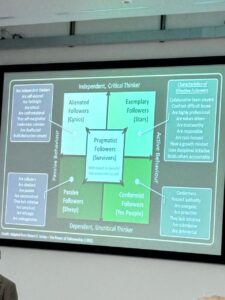I recently attended some great sessions at the Global Followership Conference in Glasgow, Scotland. Here is a wrap-up of some of the trends happening right now in followership.
What is Followership?
Followership refers to the role and behaviors of individuals within a group or organization who align themselves with a leader and contribute to the achievement of common goals. While leadership often takes the spotlight, followership is an equally essential and dynamic component of any organizational structure. Followership is not a passive role; it involves active engagement, collaboration, and a sense of shared purpose. Successful organizations thrive when there is a balance between effective leadership and followership, with both roles contributing to the overall success and well-being of the group and organization.
Companies should consider more deeply the ramifications on followers after organizational change.
Mitchell Gurick and I led a session titled, Navigating Change and Trust Building: Examining the Impact of Organizational Dynamics and Followership in Times of Transition. After presenting our transition stories, participants also shared their own. We discussed the importance of empowerment in leadership and followership, as well as the need for trust and transparency in the workplace. One participant highlighted the significance of proactive change management, and another focused on the role of shared space and trust in successful change, while emphasizing the importance of key elements in change management. Furthermore, there was an emphasis on the need for empowerment in the workplace, alongside discussions surrounding the challenges of disempowerment in toxic systems. The lens of followership enriches discussions on organizational change by highlighting the reciprocal relationship between leaders and followers, it emphasizes the importance of communication, collaboration, and trust. This perspective underscores how empowered and engaged followers contribute to successful change initiatives while emphasizing the detrimental effects of disempowerment and lack of transparency.
Followership looks and feels different on every team, and teams evolve with newly added followers.
One session led by Anton Shufutinsky began with a silent card game. We were put into teams at a table, unable to speak to one another. Each table received a different set of directions (unknowingly), but the directions were taken away after reading. Then, without speaking, participants had to choose a dealer, play the game, and correct one another on game play. After 6 minutes, the dealers had to switch tables. Shortly after that, one player had to switch tables. Interesting observations: the leader role changed depending on who was joining the group – new additions either corrected or assimilated in with the group. Points of truth also changed – from one person in the group, to new people joining the group. The session focused on cultural awareness and adaptability in organizations. Initially, the importance of cultural sensitivity and clarity in directives was highlighted. Later, understanding power dynamics, effective communication, and leadership were emphasized. Insights were shared on game design, followership, and the ethics of rule-breaking. This session was one of the best I attended.
A Letters to Leaders Program can help build trust and retention.
In fostering trust and improving retention, leaders can adopt Sharna Fabiano’s approach of partnering with team members and prioritizing problem-solving collaboratively rather than solely asserting authority. Despite high engagement scores, organizations may still struggle with retention, prompting innovative approaches like Sharna’s “Letters to Leaders” program. The Letters to Leaders program was designed to redefine employee engagement from the perspective of followership. It asked employees to anonymously write letters to any leader in their organization about what they would say. 64 letters were collected and analyzed qualitatively without identifying information. The letters provided insights into how to better connect leaders and followers in achieving organizational goals. They addressed issues like career development, diversity, and connection. Monthly meetings with an internal employee-led team helped prioritize initiatives in response. Overall, it took a qualitative, followership-centered approach to understanding employee experiences and connecting them to leadership priorities in order to improve retention and engagement from the inside-out.
Followers play a major role in supporting, and stopping, emerging “Proto-Tyrants”.
Ira Chaleff delivered a keynote the first day on leadership and tyrants. Personal experiences growing up in a multi-generational Jewish household in 1950s Brooklyn shaped his interest in understanding why people follow certain leaders. His forthcoming book will examine how followers at different levels can make a difference in addressing emerging tyrannical tendencies in political leaders. Political context includes how a society confers authority to govern and how leaders meet the basic needs of citizens/governance. Different types of followers (citizens, activists, bureaucracy, elites, inner circle) have varying levels of power and influence over political leaders. It’s important to identify emerging “proto-tyrants” early on before they consolidate power, as this is a stage where followers can still make a difference.
Followership is intertwined with leadership.
The best session I attended was delivered by the British Army’s Centre for Army Leadership. The British Army developed The British Army Followership Doctrine to improve leadership and operational effectiveness. While the army had been practicing leadership for over 350 years, followership was a newer concept that they wanted to formally introduce and champion. The Center for Army Leadership, which is responsible for leadership development across the British Army, led the work to produce the followership doctrine. It provides a framework to help soldiers and leaders understand concepts like followership behaviors and the relationship between leaders and followers. The goal was to optimize the human dimension of leadership and decision-making in order to better achieve objectives and improve soldiers’ lives. By incorporating followership into their leadership philosophy, the army hopes to develop excellence in both leadership and followership.
The discussion centered on leadership and followership within a military context, drawing from the experiences of panelists from the British Army. They shared insights into leadership styles, the dynamics between leaders and followers, and decision-making processes. A key point highlighted was the close relationship between leadership and followership. The presentation introduced the British Army’s new followership doctrine, aiming to enhance operational capability and soldiers’ well-being by promoting followership excellence. Various models of followership, including the five pillars of purpose, trust, loyalty, commitment, and belief, were presented. Advocating for the integration of a followership philosophy across the organization, the conversation addressed issues such as toxicity in leadership. The panelists also discussed the importance of cultural understanding for effective leadership.

The four panelists were:
- Lieutenant Colonel Langley Sharp, the former head of the Center for Army Leadership.
- Colonel Simon Lash, head of HR for the Royal Military Academy.
- Major David Love, Chief of Staff at the Centre for Army Leadership.
- Sargent David Chant, WO1 Leadership at the Centre for Army Leadership.


